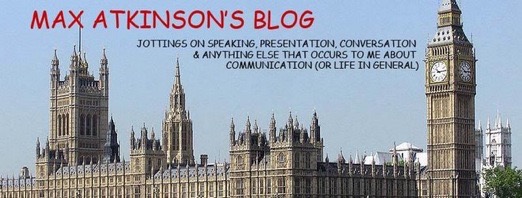When I show clips of top politicians in action to illustrate the power of rhetoric and imagery, people sometimes react by saying that such techniques may be all very well in political speeches but wouldn’t be much use in the kind of technical presentations they have to do.
It's alright for Barack Obama to say things like "The road ahead will be long. Our climb will be steep", as he did in his victory speech in Chicago, but conjuring up images of journeys and hills isn't the kind of thing that professionals like economists and bankers can do.
My usual reply to such reactions is that nothing could be further from the truth - because I've yet to come across any subject where rhetoric and imagery can't be used to make a point more clearly and/or effectively.
The following transcript and video clips provide a nice illustration of how rhetorical techniques (including contrasts, a puzzle-solution format and a three-part list) and imagery can be used to discuss the ongoing financial crisis. Complicated it may be, but here we have a Nobel prize-winning economist (Joseph Stiglitz) talking about an economy going into "a tailspin", using a contrast (between two points in time and two contrasting facts) followed by a medical metaphor (“the cure is worse than the disease”).
The video then cuts to a segment from a prime-time (UK) television news broadcast (from ITN) in which the newsreader starts by using a puzzling headline that gets us wondering what the governor of the Bank of England's "most downbeat prediction yet about the economy” actually is and a solution that seems to be using an image (“the ‘nice’ decade is over”) – though actually Mr King's use of "nice" is a reference to an acronym for 'Non-Inflationary Consistent Expansion', that's been used by economists to describe the sort of growth the UK has experienced since Labour came to power in 1997.
He then uses a three-part list and a metaphor (“travelling along a bumpy road”) that’s immediately picked up by a reporter, who continues the journey imagery (“en route”) and sums the problem up with a simple contrast (“high inflation and low growth”).
It’s worth comparing this with another news programme featured in a previous blog entry on 9th October 2008 ('PowerPoint Peston' - click here to view) and reflecting on which way of getting messages across is easier to follow.
TRANSCRIPT OF VIDEO CLIPS:
Stiglitz:
[METAPHOR] When the largest economy in the world goes into a tailspin it's going to have global repercussions.
[A] Before the Iraq war the price of oil was twenty-five dollars a barrel.
[B] Now it’s over a hundred and ten dollars a barrel.
[METAPHOR] The cure is worse than the disease.
Newsreader:
[P] The governor of the Bank of England made his most downbeat prediction yet about the economy.
[S] What Mervyn King called 'the nice decade' is over.
King:
[1] The nice decade is behind us.
[2] The credit cycle has turned.
[3] Commodity prices are rising.
[METAPHOR] We are travelling along a bumpy road as the economy rebalances.
Reporter:
So we’re all now traveling along the governor’s bumpy road.
[A] En route, high inflation
[B] and low growth.
High-risk practical joke for an office Christmas party speech

If you have to make a speech that involves presenting someone with a gift, you could try something that was done at a farewell party for a colleague who was leaving.
Unknown to the audience, the speaker had two identical gift-wrapped boxes. The real present, a decanter and glasses, bought with money collected from colleagues in the room, was hidden under the table; the one on public view was a box full of broken glass.
While presenting the ‘gift’, the speaker dropped it on the floor. The clatter of broken glass prompted collective gasps of dismay – that were quickly replaced by laughter and applause when he came clean, retrieved the undamaged gift from under the table and presented it to their departing colleague.
Not all recipients, of course, would be very amused by such a prank, so think carefully about whether it’s worth the risk before deciding to go through with it (and don't blame me if it doesn't work).
End of year poll on PowerPoint presentations
If you haven't noticed it yet, there's now an end of year poll with one simple question:
How many inspiring PowerPoint presentations have you attended during 2008?
If you'd like to vote, you'll find it on the left, just below the Blog Archive.
How many inspiring PowerPoint presentations have you attended during 2008?
If you'd like to vote, you'll find it on the left, just below the Blog Archive.
Subscribe to:
Posts (Atom)
